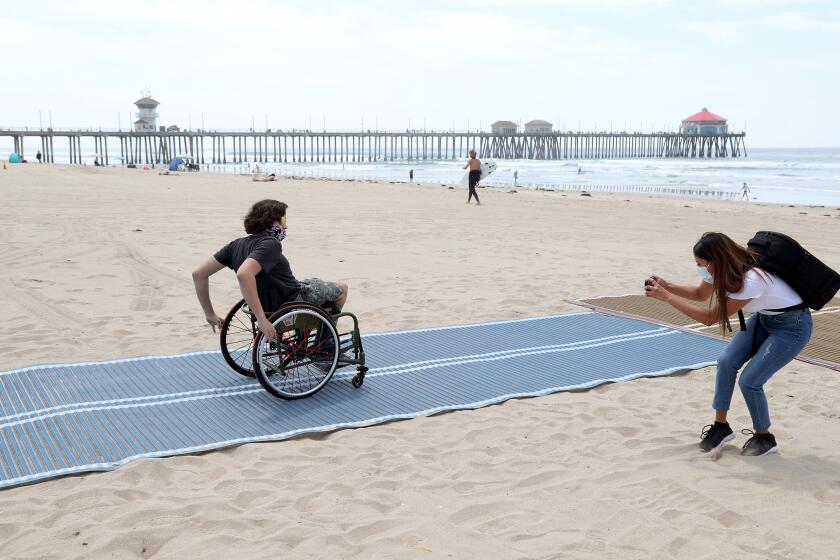Big changes around town
- Share via
VIC LEIPZIG AND LOU MURRAY
A female Cooper’s hawk has been hanging out in our yard. With a gray
head, red breast, and long black and white striped tail, she’s a
beauty. She likes to sit on the support pole for our bird feeders,
looking down at the seed tray. But naturally, no little finches or
sparrows will come to eat with her sitting there. Eventually she
flaps into a nearby tree where she waits in hiding for their return.
When the hawk preens on her pole perch, Vic and I get a great view
from our adjacent offices. Vic thought that we should write about
her. I suggested that we drive around town instead, looking for a
different column topic. Off we went, leaving Ms. Hawk to fluff her
feathers by herself.
We started our quest at the south end of town. The sand dunes
along Pacific Coast Highway are being cleared by Caltrans before they
hand the sand strip over to the Huntington Wetlands Conservancy. We
had heard that Caltrans workers were removing nonnative plants like
Myoporum and pampas grass, but it looked like they were simply
clear-cutting a swath along the highway.
We noticed nonnative plants being left on the inland side of the
dunes, and native plants being removed immediately adjacent to the
highway. Let’s hope that this initial plant removal is merely to
create some work space, and that they’ll get into the deeper brush to
remove the invasive nonnatives there before they quit.
One species of plant that Caltrans was cutting back was sandbar
willow, a lovely native tree that grows in moist sand. Sandbar
willows have very narrow leaves, delicate branches, and an
aesthetically pleasing shape if given enough room to grow. But these
willows were packed together tighter than sunbathers at the beach on
a summer Sunday. And like many sunbathers, their shapes were far from
pleasing. This overcrowded area could use a bit of thinning as well
as pruning.
Lena Hayashi volunteers with both the Huntington Wetlands
Conservancy and Shipley Nature Center. She asked if the Friends
wanted any cuttings from the sandbar willows. The branches will root
readily in moist potting soil or a bucket of water. They’ll even root
if they’re just stuck in the ground.
Mabel Alazard, the nursery coordinator for the Friends, went with
Lena to collect a few cuttings. They brought back three large trash
cans full of branches, each capable of growing into a shapely tree.
Thus the Caltrans clearing project will benefit habitat at the south
end of town, as well as in Central Park and possibly Bolsa Chica.
I trimmed the leaves and side branches from several inch-thick
willow cuttings and asked Vic for help with digging. He called Phil
and Judi Smith, and they enlisted the aid of their 6-year-old
granddaughter Ruby. It was actually Ruby who did most of the work
planting the willow stakes at Shipley Nature Center. All her
grandparents did was carry the tools, dig the holes, haul water in
buckets, and other easy tasks.
Ruby had a great time and wants to come plant more trees. I’m sure
her grandparents will oblige as soon as their blisters heal and their
chiropractor declares their backs and knees medically fit. We have
two more buckets of willows waiting for them.
Still searching for column material, Vic and I took another drive,
this time to the Bolsa Chica. What a thrill that was. The lowlands
are full of earthmoving equipment. Bulldozers are scraping away dirt.
The contours of the new ocean entrance are already taking shape. The
loop trail is now closed to the public for safety, but people still
can walk across the boardwalk and watch the construction through the
fence.
Construction will take another three years, and actual restoration
with colonization by native plants and invertebrates will take even
longer. But at least the process has finally started. The sight of
all that positive change brought goose bumps. Or maybe it was the
cold breeze that signaled the approach of yet another winter storm
that sent those chills down our spines.
Unable to walk around the loop trail for now, we moved on to
Wieder Park off Seapoint. This small county park was restored with
California native plants last year. The plants have become
established and are already providing good habitat for insects and
birds. We were excited to find a blue-gray gnatcatcher feeding in the
coastal sage scrub there. Wieder Park is turning into a decent spot
for birders, with red crossbills sighted there last week.
The afternoon sun was slipping heavily into the sea, so we headed
home. We checked the backyard for birds, and found our female
Cooper’s hawk sitting in one of our big cypress trees. She had caught
a hapless sparrow and was methodically ripping it into bite-sized
pieces and gulping them down. She must do this every day to survive.
We have plenty of house sparrows and house finches in the yard, so
we don’t mind that she culls the flock. We think it’s neat to have a
hawk in our yard. We get to watch her hunt every day while we sip
coffee in the comfort of our offices.
It’s amazing to see life and death struggles in our own backyard.
And it’s a delight to see so many positive changes to our local
wildlife habitat all around town. This is a great place to live.
* VIC LEIPZIG and LOU MURRAY are Huntington Beach residents and
environmentalists. They can be reached at vicleipzig@aol.com.
All the latest on Orange County from Orange County.
Get our free TimesOC newsletter.
You may occasionally receive promotional content from the Daily Pilot.









